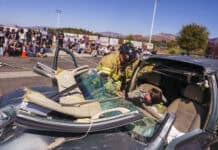Eight hours, every other night, an electronic orchestra performs alongside the bed of Nell Benson.
By Nate Hansen
Larson Newspapers
________________
Eight hours, every other night, an electronic orchestra performs alongside the bed of Nell Benson.
The sounds of cycling fluids harmonize with the low hum of a refrigerator-sized computer. The subtle echo of simulated ocean waves roll down the hall.
?Swish, swish, swish,? Benson says, describing the sound.
?It?s more of a white noise,? she adds.
Benson says the sound has become a euphony to her and her husband, Wayne Bell. After all, the sound comes from a Fresenius 2008K a dialysis machine calibrated to keep Benson alive.
Benson and Bell arrive home early from their Valentine?s Day dinner Wednesday evening. They don?t mind the early departure, as they need to prepare for the night?s dialysis.
?It usually takes two hours to set up,? Bell says, looking over equipment he and his wife both manage.
Beside Benson, attached to the dialysis machine, is a line of tubing with two ends colored red and blue. Before she lies down to sleep, she will attach the two ends to matching ends on a catheter in her chest.
According to Benson and Bell, the red end draws out the arterial blood, which flows into the Fresenius 2008K. This machine filters the ?bad blood? through a semipermeable membrane called a F70NR capillary dialyzer. It removes waste products, such as potassium and urea, from the blood.
Simultaneously, the dialysis fluid cleanses the blood with bicarbonate. It?s then reintroduced into the body through the blue end of the catheter.
?This thing won?t let you make a mistake,? Bell says.
Bell displays a six-inch thick manual on directions how to run the machine. He then laughs as he explains there?s always nurses and technicians on call 24 hours a day if anything should go wrong.
Jerry Bell is the nurse administrator and program manager for Camelback Dialysis? DaVita at Home. It?s the Scottsdale clinic and program where Benson is a patient.
Bell started working in the dialysis field in 1974. He says DaVita at Home?s home hemodialysis offers patients flexibility with treatment schedules and allows them the opportunity to live life to the fullest.
People with chronic renal disease are able to conduct dialysis at home in eight-hour sessions a few nights a week, or five to six days a week in two to three hour sessions, he says.
?People are able to gain control of their lives,? Bell says.
?Our folks are people, not patients ? we fit dialysis to fit their lives, not their lives to fit dialysis,? Bell adds.
Wayne Bell tests the machine and attached components as his wife performs her predialysis routine.
Bell inspects two water softeners that run water into a reverse osmosis machine for desalination. After the water is desalinized, it runs into the Fresenius 2008K.
During the process, Bell checks the conductivity and pH of the water.
In the meantime, Benson takes her temperature and measures her blood pressure and body weight. She does this before and after treatment.
?I think either one of us could work as a dialysis technician,? she laughs.
According to Dr. Devin Mikles, Benson?s primary care physician from Verde Valley Medical Center, Benson was hit by an insidious onset of kidney failure in November 2001.
Mikles says a biopsy revealed an uncommon kidney disease called pauci-immune crescentic glomerulonephritis. This autoimmune disease is one in which the body makes antibodies against its own tissues, he says.
Two years later, while Benson was in Mexico, Mikles says she developed a widespread form of the autoimmune disease called anti-neutrophil cytoplasmic antibody multisystem vasculitis.
The results were severe body rashes, lung vessel inflammation, pulmonary hemorrhaging and acute seronegative inflammatory arthritis.
?Nell [Benson] barely made it home to receive treatment and presented in a critical state,? Mikles says.
After aggressive treatments at VVMC, Benson came out alive. Unfortunately, her kidneys failed completely and dialysis became necessary.
?Nell chose home hemodialysis so that she could avoid spending so much time in clinics and hospitals and have more personal freedom,? Mikles says.
?When a patient is able to take more responsibility for their own treatment, they generally will do better,? he adds.
Benson adjourns to the living room.
?In a way, I consider the whole experience a gift,? she says, surprisingly.
She?s received a second chance on life, she explains.
?There?s no hectic lifestyle, no materialism,? she says, admitting a change.
When Benson drove to Phoenix for her first dialysis, she says she was frightened.
She says she remembered the book A Course in Miracles and thought of various meditations it preached.
?I remembered, ?I Rest in God,?? she says.
Benson remembers that day as she remembers the few months three years ago she spent not knowing whether she was going to live or die.
She pauses a moment, tearful that her next step is only to wait wait for a kidney transplant.
?Despite all that was going on, I felt everything was all right. I was in complete acceptance,? she recalls.
Benson turns to glance at a photo of herself and her husband posed on their Harley-Davidson.
She loves the motorcycle?s powerful roar, she says.
?Everything will be all right,? she smiles.



















